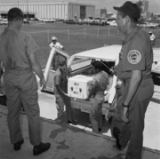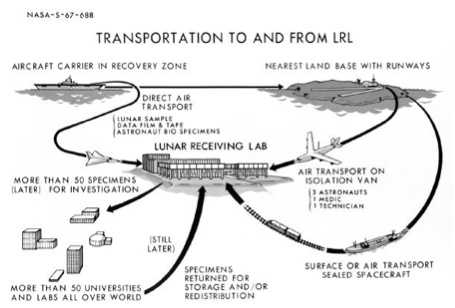
Lunar Receiving Laboratory
Encyclopedia
The Lunar Receiving Laboratory (LRL) was a facility at NASA
's Lyndon B. Johnson Space Center
(Building 37) that was constructed to quarantine
astronauts and material brought back from the Moon
during the Apollo program to mitigate the risk of back-contamination
. After recovery at sea, crews from Apollo 11
, Apollo 12
and Apollo 14
walked from their helicopter
to an isolation van on the deck of an aircraft carrier
and were brought to the LRL for quarantine. Samples of rock and regolith
that the astronauts collected and brought back were flown directly to the LRL and initially analyzed in glovebox
vacuum chamber
s.
The quarantine requirement was dropped beginning with Apollo 15
and the LRL was used for study, distribution and safe storage of the lunar samples. Between 1969 and 1972, six Apollo space flight missions brought back 382 kilograms (842 pounds) of lunar rocks, core samples, pebbles, sand and dust from the lunar surface. The six space flights returned 2200 separate samples from six different exploration sites on the lunar surface. (Other lunar samples were returned to Earth by three automated Soviet spacecraft, named Luna 16
, Luna 20
, and Luna 24
, which returned samples totaling 300 grams (approximately 3/4 pound) from three other lunar sites.)
In 1976 a portion of the samples were moved to Brooks Air Force Base in San Antonio, Texas
for second-site storage. In 1979, a Lunar Sample Laboratory Facility was built to serve as the chief repository for the Apollo samples. It was constructed to provide permanent storage of the lunar sample collection in a physically secure and non-contaminating environment. The facility consists of storage vaults for the samples, laboratories for sample preparation and study, a vault for sample data and records, and machinery to supply nitrogen to the cabinets in which the samples are stored and processed. http://www-curator.jsc.nasa.gov/lunar/lun-fac.cfm The Lunar Receiving Laboratory building is currently occupied by the Life Sciences division. It contains biomedical and environment labs, and is used for experiments involving human adaptation to microgravity.
NASA
The National Aeronautics and Space Administration is the agency of the United States government that is responsible for the nation's civilian space program and for aeronautics and aerospace research...
's Lyndon B. Johnson Space Center
Lyndon B. Johnson Space Center
The Lyndon B. Johnson Space Center is the National Aeronautics and Space Administration's center for human spaceflight training, research and flight control. The center consists of a complex of 100 buildings constructed on 1,620 acres in Houston, Texas, USA...
(Building 37) that was constructed to quarantine
Quarantine
Quarantine is compulsory isolation, typically to contain the spread of something considered dangerous, often but not always disease. The word comes from the Italian quarantena, meaning forty-day period....
astronauts and material brought back from the Moon
Moon
The Moon is Earth's only known natural satellite,There are a number of near-Earth asteroids including 3753 Cruithne that are co-orbital with Earth: their orbits bring them close to Earth for periods of time but then alter in the long term . These are quasi-satellites and not true moons. For more...
during the Apollo program to mitigate the risk of back-contamination
Back-contamination
Back-contamination is the informal but widely employed name for the hypothetical introduction of microbial extraterrestrial organisms into Earth's biosphere. It is assumed that any such contact will be disruptive or at least have consequences over which human beings will have little control...
. After recovery at sea, crews from Apollo 11
Apollo 11
In early 1969, Bill Anders accepted a job with the National Space Council effective in August 1969 and announced his retirement as an astronaut. At that point Ken Mattingly was moved from the support crew into parallel training with Anders as backup Command Module Pilot in case Apollo 11 was...
, Apollo 12
Apollo 12
Apollo 12 was the sixth manned flight in the American Apollo program and the second to land on the Moon . It was launched on November 14, 1969 from the Kennedy Space Center, Florida, four months after Apollo 11. Mission commander Charles "Pete" Conrad and Lunar Module Pilot Alan L...
and Apollo 14
Apollo 14
Apollo 14 was the eighth manned mission in the American Apollo program, and the third to land on the Moon. It was the last of the "H missions", targeted landings with two-day stays on the Moon with two lunar EVAs, or moonwalks....
walked from their helicopter
Helicopter
A helicopter is a type of rotorcraft in which lift and thrust are supplied by one or more engine-driven rotors. This allows the helicopter to take off and land vertically, to hover, and to fly forwards, backwards, and laterally...
to an isolation van on the deck of an aircraft carrier
Aircraft carrier
An aircraft carrier is a warship designed with a primary mission of deploying and recovering aircraft, acting as a seagoing airbase. Aircraft carriers thus allow a naval force to project air power worldwide without having to depend on local bases for staging aircraft operations...
and were brought to the LRL for quarantine. Samples of rock and regolith
Regolith
Regolith is a layer of loose, heterogeneous material covering solid rock. It includes dust, soil, broken rock, and other related materials and is present on Earth, the Moon, some asteroids, and other terrestrial planets and moons.-Etymology:...
that the astronauts collected and brought back were flown directly to the LRL and initially analyzed in glovebox
Glovebox
A glovebox is a sealed container that is designed to allow one to manipulate objects where a separate atmosphere is desired. Built into the sides of the glovebox are gloves arranged in such a way that the user can place their hands into the gloves and perform tasks inside the box without breaking...
vacuum chamber
Vacuum chamber
A vacuum chamber is a rigid enclosure from which air and other gases are removed by a vacuum pump. The resulting low pressure, commonly referred to as a vacuum, allows researchers to conduct physical experiments or to test mechanical devices which must operate in outer space...
s.
The quarantine requirement was dropped beginning with Apollo 15
Apollo 15
Apollo 15 was the ninth manned mission in the American Apollo space program, the fourth to land on the Moon and the eighth successful manned mission. It was the first of what were termed "J missions", long duration stays on the Moon with a greater focus on science than had been possible on previous...
and the LRL was used for study, distribution and safe storage of the lunar samples. Between 1969 and 1972, six Apollo space flight missions brought back 382 kilograms (842 pounds) of lunar rocks, core samples, pebbles, sand and dust from the lunar surface. The six space flights returned 2200 separate samples from six different exploration sites on the lunar surface. (Other lunar samples were returned to Earth by three automated Soviet spacecraft, named Luna 16
Luna 16
-External links:*...
, Luna 20
Luna 20
Luna 20 was the second of three successful Soviet lunar sample return missions. It was flown as part of the Luna program, also called Lunik 20, as a robotic competitor to the six successful Apollo lunar sample return missions....
, and Luna 24
Luna 24
-External links:*...
, which returned samples totaling 300 grams (approximately 3/4 pound) from three other lunar sites.)
In 1976 a portion of the samples were moved to Brooks Air Force Base in San Antonio, Texas
San Antonio, Texas
San Antonio is the seventh-largest city in the United States of America and the second-largest city within the state of Texas, with a population of 1.33 million. Located in the American Southwest and the south–central part of Texas, the city serves as the seat of Bexar County. In 2011,...
for second-site storage. In 1979, a Lunar Sample Laboratory Facility was built to serve as the chief repository for the Apollo samples. It was constructed to provide permanent storage of the lunar sample collection in a physically secure and non-contaminating environment. The facility consists of storage vaults for the samples, laboratories for sample preparation and study, a vault for sample data and records, and machinery to supply nitrogen to the cabinets in which the samples are stored and processed. http://www-curator.jsc.nasa.gov/lunar/lun-fac.cfm The Lunar Receiving Laboratory building is currently occupied by the Life Sciences division. It contains biomedical and environment labs, and is used for experiments involving human adaptation to microgravity.
External links
- Lunar Receiving Laboratory Project History NASA/CR–2004–208938, 2004
- 25 Years of Curating Moon Rocks, Judy Allton


